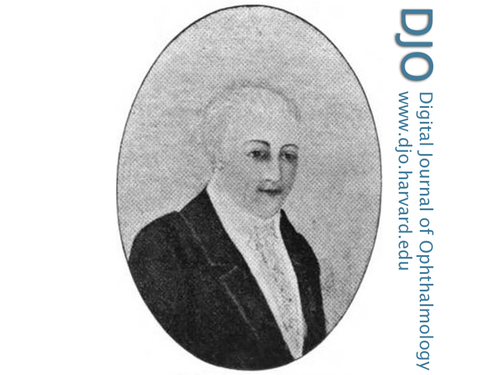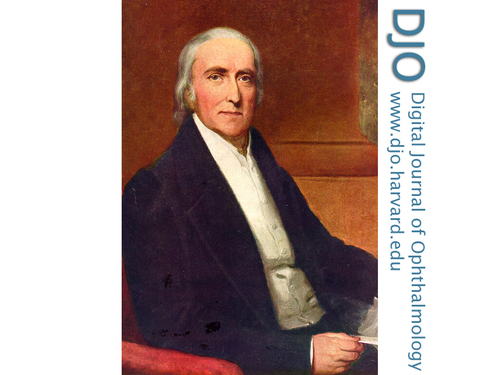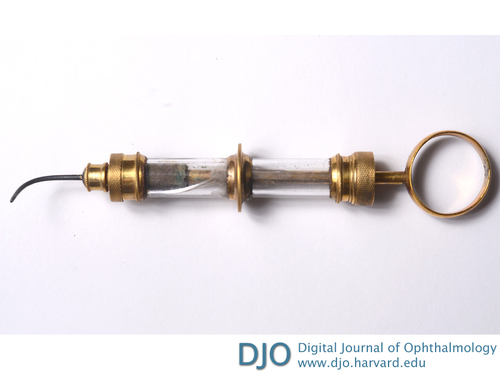|
|
 |
 |
 |
 |
|
|
Aspiration of cataract in 1815 in Philadelphia, Pennsylvania
Digital Journal of Ophthalmology 2017
Volume 23, Number 4
December 30, 2017
DOI: 10.5693/djo.01.2017.10.001
|
Printer Friendly
Download PDF |
|
|


 Christopher Leffler, MD, MPH
Christopher Leffler, MD, MPH | Department of Ophthalmology, Virginia Commonwealth University, Richmond Charles E. Letocha, MD | Cogan Ophthalmic History Society, York, Pennsylvania Kasey Pierson, MD | Department of Ophthalmology, Virginia Commonwealth University, Richmond Stephen G. Schwartz, MD, MBA | Department of Ophthalmology, Bascom Palmer Eye Institute, University of Miami Miller School of Medicine, Naples, Florida
|
|
|
| Abstract | | We present and discuss the previously unrecognized evidence for the possible introduction of cataract extraction by aspiration into modern Western medicine on March 26, 1815, in Philadelphia, Pennsylvania, by surgeon Philip Syng Physick. On this date, he successfully extracted a cataract by suction through a tube, according to newspaper reports written by the patient, an attorney who sought a patent on the suction device. Aspects of the patient’s account are confirmed by supporting evidence from the medical community and by a cataract instrument set attributed to Physick, which includes a cannula attached to a syringe. The evidence suggests that Physick was the first to reintroduce cataract aspiration to Western medicine. | | | Body | Cataract extraction by suction through a narrow tube may have been attempted from time to time since antiquity. An early account of such a procedure comes from 11th-century Cairo,(1-4) where Ammar ibn Ali Mawsili wrote that he “imagined and manufactured a hollow cataract needle . . . No one practiced the operation for cataract with the aid of this needle before me.”(2) Ammar described cataract extraction using the hollow needle in a man from Tiberias, who could see immediately and then had the eye dressed for 7 days.(2,4) A handful of authors mentioned the technique subsequently, but most were skeptical of its efficacy.(1-4) One reviewer of Islamic medicine concluded that “the operation was very rarely, if ever, undertaken and then probably unsuccessfully. Yet if that interpretation is accepted, we must reject Ammar’s ‘case histories’ as evidence of its successful performance.”(3) In fact, all but one of Ammar’s case histories described the standard couching technique.(2)
The idea never completely disappeared, and the theory of aspirating the lens by oral suction was discussed by Italian surgeon Giuseppe Francesco Borri in a letter of 1669.(5) Shortly thereafter, Dutch surgeon Anton Nuck (1650-1692) claimed to have removed vitreous by suction in a young patient with an inflamed eye.(6) According to standard accounts, the actual practice of cataract aspiration was reintroduced by Stanislas Laugier of France in 1847.(1,4) However, we have uncovered an earlier, 19th-century practitioner of cataract aspiration.
In 1815, 39-year-old attorney Francis B. Shaw (ca. 1776-1832; Figure 1)(7) reported that he had been “deprived of sight by Cataract” for over 2 years and was forced to abandon his law practice until surgeon Philip Syng Physick of Philadelphia (Figure 2) successfully aspirated the cataract.(8.9) Initially, surgeon John Syng Dorsey, Physick’s nephew, had operated on Shaw 3 times using the method of division, which enjoyed widespread popularity during this period.(8,10) This method involved breaking the cataract with a needle so that the remnants could be absorbed by the natural inflammatory mechanism over a period of months.(11) Dorsey described his technique as follows: after dilating the pupil with stramonium, he introduced a needle through the cornea with which “the capsule and lens are to be torn in pieces: fragments of the lens can often be pushed forward into the anterior chamber of the eye, where they speedily dissolve.”(12)
When this technique failed, Shaw proposed “drawing away the cataract and completely emptying the capsule of the lens.”7 Despite his poor vision, he designed the instruments, which he called “Tubes and Canular-points”(13) and which were constructed by “an ingenious artist” under Shaw’s direction.(8)
Shaw experimented with “different substances, as similar as possible to that of the cataract.”(8) Using this method, Physick “completely removed every vestige of the Cataract, and the patient was once more restored to sight. . . .”(8) Shaw was the first patient operated on with this method,(14) and he was able to resume the practice of law within 3 months.(15)
That summer Shaw obtained a federal patent for the system(14) for “Cataract, removing, by tubes.”(16) Advantages included the ability to operate on cataracts at early stages before hardening or maturation and the fact that the lens capsule “is instantaneously fitted with a portion of the vitrious [sic] humor, and thereby its natural convexity preserved.”(14) Of course, the refractive index of vitreous is too low to replace the lens. Still, Shaw might have imagined that post-lensectomy ocular refractive function could be maintained with proper intracapsular contents, just as we do today with intraocular lenses. However, the state of Pennsylvania declined to purchase the patent rights in early 1816, because the method had only been used on 2 patients.(13)
Shaw had a financial interest in the matter, was not a surgeon, and did not describe the technique in detail. Therefore, it has been difficult to know how much to credit his account. Previously historians have found no evidence from within the medical community to confirm that Physick aspirated cataracts.
Account of Surgeon Samuel White
On June 8, 1815, surgeon Samuel White (1777-1845) of Hudson, New York,(17) wrote to a fellow eye surgeon that he had “just returned from a tour” through hospitals in New York and Philadelphia and (Figure 3):
I have also procured from Doct Physick his new invented Tubular instrument for extracting by suction the diseased lens when fluid. Shaw as was noticed in the papers, is not entitled to any credit for the construction. The operation is performed by Doct Physick by introducing a crow Lancet obliquely down thro’ the cornea to the pupil, dipping the point so as to break the capsule, a curved silver tube is then introduced through the opening with the mouth of the tube on the back point, so as to be in contact with the lens, the operator then draws in the lens by suction and withdraws the instrument from the eye. Doctor P. thinks this instrument may be improved to great advantage in cases of milky or fluid cataract—effecting in a few moments what otherwise might require months by absorption.(18)
Evidence from Philadelphia
In 1816 Dorsey wrote, “Dr. Physick has successfully performed the ancient operation of sucking out a cataract by a small tube introduced through a puncture in the cornea. The operation is, however, attended with difficulties which will necessarily prevent its general adoption. . . .”(12) A set of cataract instruments attributed to Physick contains just one instrument resembling a “tube”: a syringe that attaches to either a curved or straight cannula.(19) This instrument would appear suitable for cataract aspiration (Figure 4). The University of Pennsylvania faculty did use syringes during this period,(20) specifically for aspiration of bodily fluids.(21)
Postscript
Fourteen years after surgery, Shaw’s vision was still sufficient for him to practice law.(22) In the mid 1800s, Laugier and others in Europe practiced aspiration of suitable cataracts.(1,4) Cataract aspiration became the dominant extraction technique only after 1967, when Charles Kelman reported preliminary results in breaking up the cataract by phacoemulsification.(23) | |

Figure 1
Francis B. Shaw (ca. 1776-1832).(7)
|
|

Figure 2
Philip Syng Physick (1768-1837) of Philadelphia.
|
|

Figure 3
Letter of surgeon Samuel White, dated June 8, 1815, describing cataract extraction by suction.(18)
|
|

Figure 4
Cannula attached to a syringe, from the cataract surgery instruments attributed to Philip Syng Physick, displayed at the Physick House in Philadelphia. Courtesy of the College of Physicians of Philadelphia.
|
|
| References | 1. Pérez-Cambrodí RJ, Ascaso FJ, Diab F, Alzamora-Rodríguez A, Grzybowski A. Hollow needle cataract aspiration in antiquity. Acta Ophthalmol 2015;93:782-4.
2. 'Ammār ibn 'Alī Mawsilī, Meyerhof M. Las Operaciones de catarata de 'Ammar ibn 'Ali al-Mawsili. Barcelona, Spain: Laboratories del Norte de Espana; 1937:35-57.
3. Savage-Smith E. The practice of surgery in Islamic lands: myth and reality. Soc Hist Med 2000;13:307-21.
4. Hirschberg J, Blodi FC. The History of Ophthalmology. Vol. 2. The Middle Ages: The Sixteenth and Seventeenth Centuries. Bonn: Wayenborgh; 1985:231-41.
5. Koch HR, Koch KR. Borri, the Prophet, on the “Restitutio Humorum” and on lens aspiration in the 17th century. Proceedings of the Cogan Ophthalmic History Society. New York, New York; 2015:246-62.
6. Leffler CT, Schwartz SG. A family of early English oculists (1600-1751), with a reappraisal of John Thomas Woolhouse (1664-1733/1734). Ophthalmol Eye Dis 2017;9:1179172117732042.
7. Davis WW. History of Doylestown, Old and New. Doylestown, PA: Intelligencer Print; 1905:31-80.
8. Shaw FB. From the Philadelphia Daily Advertiser. Interesting Surgical Operation. Commercial Advertiser. April 3, 1815. New York, New York; XVIII(7063):2.
9. Letocha CE, Albert DM. 1815 Version of phacoemulsification? Arch Ophthalmol 2010;128:19.
10. Leffler CT, Schwartz SG, Wainsztein RD, Pflugrath A, Peterson E. Ophthalmology in North America: early stories (1491-1801). Ophthalmol Eye Dis 2017;9:1179172117721902.
11. Leffler CT, Wainsztein RD. The first cataract surgeons in Latin America: 1611-1830. Clin Ophthalmol 2016;10:679-94.
12. Cooper S, Dorsey JS, ed. A Dictionary of Practical Surgery. Vol. 1. Philadelphia: Kite; 1816:290.
13. Journal of the Twenty Sixth House of Representatives of the Commonwealth of Pennsylvania. Harrisburg; 1816:204-96.
14. Shaw FB. The undersigned informs the public that he has obtained from the Department of State a Patent. Baltimore Patriot. August 24, 1815;VI(830):3.
15. Shaw FB. Francis B. Shaw . . . has resumed the Practice of the Law. Pennsylvania Correspondent, and Farmers’ [Doylestown, Pennsylvannia] Advertiser. June 26, 1815:3.
16. Burke E. List of Patents for Inventions and Designs: Issued by the United States, from 1790 to 1847. Washington: Gideon;1847:341.
17. Obituary Notice. New York Journal of Medicine and the Collateral Sciences. Vol. 4. New York: Langley. May 1845:425-6.
18. White S. Letter from Samuel White to Mason Fitch Cogswell. June 8, 1815. Mason Fitch Cogswell Papers. General Collection, Beinecke Rare Book and Manuscript Library, Yale University. Series 1, Box 3, Folder 89.
19. Albert DM, Scheie HG. A History of Ophthalmology at the University of Pennsylvania. Springfield, IL, Thomas; 1965:11.
20. Dorsey JS. Elements of surgery; for the use of students. Vol. 1. Philadelphia, E. Parker; 1813:297.
21. Dorsey JS. Elements of surgery; for the use of students. Vol. 2. Philadelphia, E. Parker; 1813:149-408.
22. Appointment by the Attorney General. Francis B. Shaw to be deputy attorney general for Bucks County. Philadelphia Inquirer. Philadelphia, PA; July 23, 1829:2.
23. Kelman CD. Phaco-emulsification and aspiration: a new technique of cataract removal: a preliminary report. Am J Ophthalmol 1967;64:23-5. | |
|
 |
 |
 |

|
|
 Welcome, please sign in
Welcome, please sign in  Welcome, please sign in
Welcome, please sign in